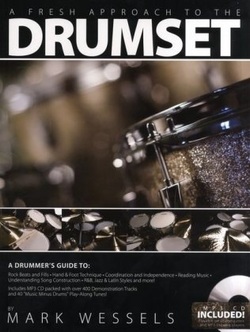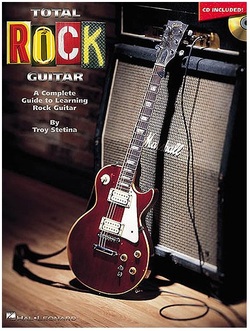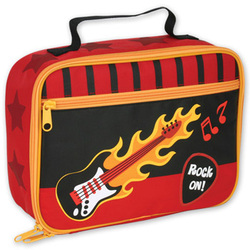
If you want to improve as a musician, you need to listen to good musicians. This is actually one of the easiest things we can do to grow, but it's often overlooked. I play drums so I'm going to talk in terms of drums and drummers, but this principle is true for any musician.
As a drummer, I want to listen to the best drummers I can as much as I can. By listening to top notch drummers, my musical imagination is stretched. Now I can't always play what they play just by listening, but over time I start to think like them. And with practice, eventually things start to show up in my playing that resemble things I've heard and seen them do.
Now, if I only listen to one band, I will eventually sound like the drummer for that band. If I listen to lots of drummers from lots of different bands and different genres, my imagination grows evenly and I become a much more well-rounded drummer that can play lots of different styles. This will make you a better drummer overall and will give you a greater appreciation of all music. Don't be narrow-minded and arrogant about your style of music. No genre is all-encompassing and no style is a complete waste of time. All have unique facets that are beneficial to a drummers well-rounded growth. You might be wondering how you can listen to great drummers without spending tons of money on expanding your music library? Well, there are lots of ways, but my favorite resource is a website called Drummerworld. It offers videos and recordings of the worlds top drummers as well as transcriptions, forums, and many other resources and is completely free. So be diligent and consistent in your practice, but make sure to also listen to great musicians. You'll grow faster and be a better musician for it. -Jonathan  NOTE FROM SHANE...
Jonathan and I met in college and have been friends for almost 10 years. We played together in a college ensemble before I joined him in the rock megagroup Hope's Fish. Jonathan is a skilled drum educator and has played with church orchestras and praise teams, acoustic acts, and full-out rock explosions. He currently lives in Nashville, TN.
I am glad to have him on board as a guest blogger at stickandstrum and know that he will teach and give insight into areas that I lack. If you have any questions or comments, feel free to leave them below! Check out Jonathan's current band, The Redding Shift.

Hey guys! Sorry for the delay! Life has been kind of crazy this month.
Originally I was going to title this blog, The Importance of Groove. Then, I got a call to go record so I was going to call it Preparing for the Studio. Later I got a call later that the recording session got postponed. The next week I found out that I was passed over for a gig by a good friend of mine who went with someone who had better "feel". My ego was bruised and I was feeling much less confident in my ability to play so I was going to write about Attitude and again the Importance of Groove\Feel. THEN I got the call that the recording session was back on. It's funny how God works things out because I swear the session was the perfect object lesson on ALL of the topics I wanted to cover...
I leave my house at 6 am on Saturday (yep, even musicians have to wake up early sometimes!), drive two hours to the studio, and get setup for an 8 am session. After waiting for more than an hour, the leader of the band finally finished laying scratch tracks [note: scratch tracks are tracks that provide the basic feel of the song for musicians to record to but are later replaced with 'real' tracks] and I was ready to go! (or so I thought).
I got together with the bandleader last week to discuss the two songs we were going to record and practiced accordingly (Preparing for the Studio). The bandleader said that he wanted to make one song sound really "poppy". So, I put on my pop drummer hat and played a take...only to hear this from the control room, "Umm....That was good....could you play it again....but, this time without the fill......or..." I would do another take and change it up a bit just to hear the same thing about 15 times...which is both frustrating and makes you feel like you don't know what you're doing.
I didn't complain and did my best to give the band leader what he wanted (Attitude). We finally got a solid take and it turned out great! I ended up playing solid quarter notes on the kick and crash to give the chorus a poppy kind of drive and it made the song feel really good (Importance of Groove).
Now I tell you guys this because I want you to know that it was actually a GREAT learning experience. Even losing the gig with my friend turned out well because I now know that I need to work on my feel. Because I didn't complain in the studio, I will get called back for possible gigs with the engineer because he said that he couldn't tell me how many other drummers would get really upset if they were told to "not play that fill here".
So here's the take home advice guys:

1. Keep practicing
2. Be flexible (be a team player)
3. Keep grooving (remember that playing simple and clean is ALWAYS better than playing your "hot new fill")
4. Play to the song
5. Even when you are feeling kinda down about your skills, Keep playing and Have fun with it!!
If you stick with it the gigs will come....that friend that went with someone else called me to play next week because his other guy couldn't make it....( I guess be reliable has some advantages too...)
- Justin
Hey guys! Before we get started, let me tell you a little about myself and where I'm coming from. My Name is Justin Pohlmann. I've been playing drums for over 11 years and have had the honor of sharing the stage with some great musicians! I've had the opportunity to play hundreds of shows, open up for national acts, and record three different albums with my former band Considered Rubbish (you can download the last album for free here: www.consideredrubbish.bandcamp.com). I currently play drums for a band called "The Trust Project", play at my church on Sunday mornings, and fill in with some different bands whenever they need me. These blogs will hopefully be able to shed some perspective on what it's like to be a gigging drummer (how to prepare for gigs, how to get gigs, etc...). I will also post lessons and things I've been working on from time to time and try to answer any questions you guys have about being a working drummer. Ok, enough about me...on with the show...  So, you've been practicing your butt off, gotten your chops up, driven your parents and neighbors completely crazy practicing for hours on end, practiced your best rock-n-roll face in the mirror (you know you have!), and maybe even gotten a band together. Now that you think your ready for the world of being a gigging drummer, let's take a look at what that looks like. It's going to sound scary so get ready.
WE GET TO BE THE FIRST ONES TO PRACTICE\SHOWS
WE GET TO BE THE LAST ONES TO LEAVE PRACTICE\SHOWS
WE GET TO HAUL THE MOST GEAR AROUND
WE TAKE THE LONGEST TIME TO SET UP AND TEAR DOWN
WE GET TO CONSTANTLY BE THE BUTT OF DRUMMER "JOKES”
WE WILL GET ASKED "CAN'T YOU JUST PLAY SOFTER?" (My personal favorite)
OUR GEAR COSTS THE MOST TO UPKEEP (sticks and heads cost way more the guitar strings!)
AND WE HAVE TO PUT UP WITH LEAD SINGERS AND GUITARISTS WHO THINK IT’S AWESOME TO JUST COME RIGHT UP, GRAB YOUR CRASH CYMBAL AND SPIN IT ON THE STAND!!! (that drives me nuts!!)
AND IF YOU EVER HAVE THE "PRIVILEGE" OF PLAYING IN A BAR, YOU WILL UNDOUBTEDLY GET DRUNKEN REQUESTS TO PLAY "WIPE-OUT"...ALOT...ALL NIGHT....
Add all of this together with hours of practice time, little to no pay, and constantly getting asked to learn new songs at the last minute and you've just about got the idea of what it's like to be a gigging drummer.
Then why do it?
Because we get to play drums!!!! Drumming is fun! When you lock into a groove, the band syncs up and everything is rocking you will know that, despite all of the hard work and long hours, it is totally worth it!!
This is just a sample of what you guys can expect while being a gigging drummer hope you guys found this helpful. Next time we start talking about the importance of groove!!
Thanks for reading!
-Justin
NOTE FROM SHANE.....
Justin and I have been friends for over twenty years. We met in kindergarten and became rock stars together before heading separate ways after high school. While I became a teacher and live a life in the suburbs, I secretly live out my rock star fantasies vicariously through him. I am glad to have him on board as a guest blogger at stickandstrum and know that he will teach and give insight into areas that I lack. Feel free to post comments below and ask any questions that you have about gigging, recording, or life as a professional drummer.
(the song playing is "With Me" by Considered Rubbish featuring Justin Pohlmann on drums. You can download the entire album for free here)
 Last year I really stepped up my drum curriculum. I went from one outdated lesson book and supplementing with Groove Essentials for a few advanced students to a more thorough and modern lesson book, lots of great supplemental material, videos, and weekly playalongs. We've focussed on rudimental studies and relied heavily on technique. The focus hasn't been as much on WHAT you play, but HOW you play it.
This is natural and healthy for a teacher. As I grow as a player and educator, my methods and curriculum may change. As new books are made available, they will be worked into the curriculum. Please do not read that I am flip-flopping methods and ditching everything for something new and shiny.
For drum students, it all comes down to rudiments, technique, and coordination. From the most simple task to the most complex, everything relies on the above three things.
Which brings me to guitar...For some reason, there is a real lack of resources for guitar education. Don't get me wrong, there are TONS of method books and songbooks. But most of these are pretty awful. They focus on strange methodologies, are overly simplified or overly difficult, and there aren't many that focus on technique. I'm not sure why this is as there is a wealth of resources available for other private instrument lessons (piano and drums, for instance).
 For years, I have been using Mel Bay's Modern Guitar Method for beginners and I still think it is the best place for beginners to learn the fundamentals of music, gain finger dexterity, and learn the basics of the instrument. I have supplemented with other books for different genres when students reach a certain level of mastery (for example, Christopher Parkening's Classical Guitar books for those interested in classical/fingerstyle guitar).
I think that variety is the key but, especially with my teenage students, I need to have something systematic and methodical to work through. Teaching random songs and techniques is fun, but it leaves a lot of holes in one's playing and is difficult with the attention span of most teens. I need something concrete that we can work through and accomplish.
So, I've been researching for a few weeks and have narrowed down the list to a few books that I'll be trying out this semester. I'm fairly confident that one of them (Total Rock Guitar) will become the new lesson book for my intermediate students interested in rock guitar, while the others will be great supplemental material.
So, here is the list of books that I'll be working through for the first few weeks until lessons begin. You can expect to see brief reviews of my initial thoughts on each book soon.
In no particular order...
Guitar Fretboard Workbook
Guitar Aerobics
Speed Mechanics for Lead Guitar
Total Rock Guitar
Chord Tone Soloing
Rhythmic Lead Guitar The Advancing Guitarist
Feel free to check these out on Amazon and let me know what you think. Reviews coming soon!
You get an hour for lunch, right? Why not come in for a 30 minute music lesson during your lunch break?It's a great way to get out of the office, focus on something other than work, and practice a fun, new hobby. I always have spots available before 3pm. If it is impractical for you to bring your guitar in to work, I have spare guitars that you can use during your lesson. There are lots of great restaurants in the area so you can grab a quick bite to eat before or after your lesson. Contact me for availability and more information.
I am VERY excited to announce that I have joined the Vic Firth Education Team. Truth be told, this happened over a month ago but I wanted to wait until it was released on their website to put it out there. Not only does Vic Firth make the best sticks out there, but they are committed to drum education in a huge way. So, what does this mean? First, I am part of a great community of drummers and educators. Secondly, I (and my students) get to try out new products like books, sticks, etc. This is a great company and I am humbled and thrilled to partner with them. You can check out my page on their website here.
I LOVE this book. Vic Firth sent me a bunch of books, sticks, and other fun goodies last week and this was in the pack. To be honest, this book has been on my radar for a while and I'm really glad that Vic Firth sent a copy over for me to check out. I've been looking for a new general lesson book for my drum students for that past year or so. I've been using Andy Griffith's Progressive Rock Drumming since I started teaching drums. It is a great text, but it is a little dated (1986) and therefore some of it's subject material doesn't apply as much as it did when it was written and they miss out on some more modern examples and techniques. As much as I love massive 80s rock drum fills, it's time to bid this book adieu. So, what's so great about Wessels' book? Here's a quick breakdown of a few points that I like thus far: 1. Diversity. Many styles are covered in an easy to use, overview-style format. 2. Backing Tracks. There are over 40 songs to play along with in this book! 3. Stick Control. The attention to rudiments and stick control is a great addition to a lesson book. 4. Layout. The layout of the book is visually appealing, and makes for a fun play along. 5. Modern. Published a couple of years ago, this book contains pertinent examples to modern drumming. Let me elaborate on a few. Books with backing tracks (songs without drum parts) are nothing new. But the tracks here are great! Not cheesy, elevator music but good, solid tracks for each genre. I am going to enjoy playing these and I know my students will too. One of the downsides of learning grooves in the Progressive Rock Drumming book is that after you learn the groove, what do you do next? This book takes almost every groove and example and gives a play along track to let the student play the groove with a band. Great concept! The tracks are perfect and never boring. You know it is a great track when the student plays and sounds better on a groove just by getting the chance to play with the track. These tracks take exercises and turn them into music! Most lesson books give a lesson or two on basic stick control and examples at the beginning of the book and then move on to 'practical matters'. If you don't continually revisit and build upon your sticking, you won't be able to play more complex material later. I really like this about Wessels' book. Not only does he give some great sticking exercises and rudiments early in the book (including singles, double strokes, and paradiddles in THE FIRST LESSON in an example that reminds me of this awesome Joe Morello exercise), but he continues to build on these throughout the book by introducing more sticking exercises and rudiments! Great concept that is easily overlooked by most drum lesson books. There also some small patterns, grooves, and fills that I haven't seen very often in other books. There's an entire section on upbeat ride cymbal patterns. This is a (somewhat) simple concept that can add a lot of diversity to a groove and give the student lots of ideas to play with, but this is the first time I have seen it laid out this well in a lesson book. The approach to jazz and world styles is also fantastic. They are easy enough to play (with some dedicated practice), but still approachable for the novice. There is something in here for everyone, from the earliest beginner through the advanced intermediate. I will be sure to post a more thorough review once I've used the book for a semester or two with some students, but I look forward to seeing what my students will do with this book and hopefully using some of the playalong tracks for the recital this year! You can buy this book and/or download a FREE sample with over 20 pages of the book and 7 play along samples here.
After a few weeks of tweaking mic placement, recording technique, and video editing I think I've finally got the hang of it! I have one more week of teaching (two at Pelham!) this semester and I plan to start recording video lessons over the month of December and have some featured at the start of our new semester in January.
Here's what the first few will likely be:
1. Subdivision Warmup for Drums
2. Basic Strum Pattern for Guitar
3. Basic Fill Ideas for Drums
What do YOU want to see? Leave me a comment!
-shane
|










 RSS Feed
RSS Feed